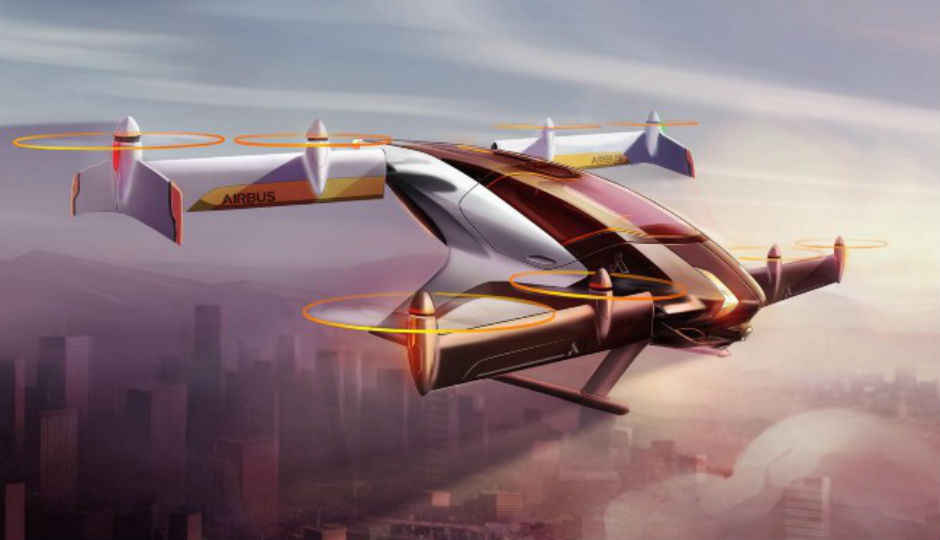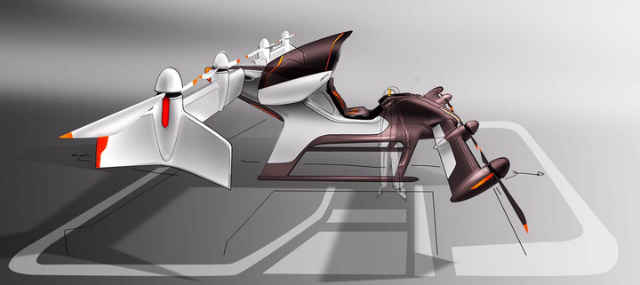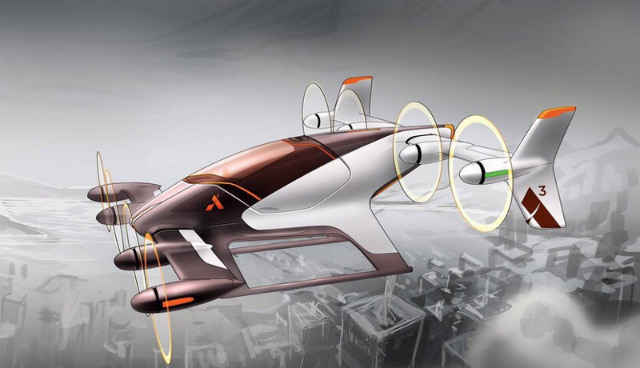Airbus Vahana, the self-flying electric air taxi, may just be how we travel in near future

Flying cars have always been the ultimate fantasy, and if Airbus is to be believed, the dream may actually come true as soon as 2020.
Think about sci-fi worlds, where the skyline is filled with buildings that rise above the clouds and the air is strewn with tiny pod-like structures that are smart enough to fly to a destination by themselves. While all of us have dreamt of living in such a world someday, rules, regulations and engineering barriers have prevented us from taking to the sky and skipping the Monday morning rush hour traffic. The concept is not entirely new, and recent interest around it has seen Uber wanting to introduce flying taxis in Dubai, a production model called PAL-V Liberty being put up for sale, and a more recent Lilium Jet has presented a mighty similar concept as the Airbus Vahana, saving the autonomous engineering bit.
It is the latter that makes this attempt more appealing, intriguing and even practical. Airbus, the aircraft manufacturer, is working on Project Vahana, which it aims to convert to reality as early as 2020. The company has taken cues from existing engineering techniques and advances in the field of self-driving cars to create a sketch of a self-flying, fully electric air taxi that can take off and land vertically, eliminating the need for runways and hence being ideal for congested cities. While the entire concept may actually seem easier said than done, Airbus really has taken every roadblock and difficulty into consideration, and the resulting blueprint is mighty promising.
The technologies used in the air taxis
Being developed at the Airbus A3 advanced project outpost, Project Vahana makes the most of mass-produced lightweight structural engineering, advancements in sensor integrations and algorithms, and development of dense energy batteries. The resultant output is an all-electric, tilt-rotor aircraft that is capable of taking off and landing on helipads, hence not requiring an airstrip to operate.
Vahana is being looked as the ultimate advancement in everyday commuting, using clean energy and autonomous flying to promote low pollution, minimal human effort and zero congestion to increase productivity and reduce the chaos that urban lifespaces are seemingly moving toward. As Rodin Lyasoff, CEO of A3 puts it, “The aircraft we’re building doesn’t need a runway, is self-piloted, and can automatically detect and avoid obstacles and other aircraft. Designed to carry a single passenger or cargo, we’re aiming to make it the first certified passenger aircraft without a pilot.”
The array of technology in the aircraft begins with the batteries, which use the highest available energy density in commercially implementable batteries right now. The present batteries give Vahana the ability to fly at peak speed of 225kmph, and last for total range of nearly 100kms. This gives Vahana total flying time of 25 minutes, and assuming that the average urban citizen lives within about 20 kilometres of his/her workplace, the Airbus Vahana will be able to ply for at least four trips per charge.
The next element of innovation is in the use of lightweight component, and the use of autonomy in flight removes the requirement of a human pilot, which in turn frees up aircraft kerb weight to increase passenger capacity and total range (a heavier aircraft would require more energy to traverse the air, thereby draining the battery faster). The recent advances in the field of lightweight material engineering has produced material that is presently being used for drones of varying shapes and power, and it is this that Airbus will implement in the Vahana. As Lyasoff says, “Recent advances in automated composite manufacturing and assembly show that small, lightweight vehicles can be produced at high volumes and significantly lower costs than traditional aerospace methods have previously allowed.”
Each of the Airbus Vahana air taxis would then include a host of imaging and sensing equipment, much like the autonomous cars that are being developed right now. The equipment will include multiple cameras, short- and long-range radars and a LIDAR unit to give the Vahana 360-degree navigability in air. Airbus will load pre-selected routes inside a city in multiple permutations and combinations to follow safety of navigation when airborne. The equipment array will allow the air taxis to automatically avoid incidental collisions. The Vahana will be able to detect individual or flocks of birds at a distance and maneuver a clear aerial route to divert to.
Additionally, each of the air taxis will be connected with each other in terms of live route viewing, and will presumably complement each other to avoid intersection of travel in mid-air. Lyasoff believes that such technology will have multiple benefits – reduce manufacturing and operational expenses, enable easier and more efficient automated airspace management that will allow more aircrafts to make use of the unused airspace. In terms of safety measures, each of these air taxis include backups to reach destination or make emergency landings (the algorithms fed in the system will take the necessary decisions depending on the extent of damage) in case one motor is lost. It will also include a short-height ballistic parachute that will deploy automatically in case of a severe accident.
Existing regulations and roadblocks
The present range of regulations and roadblocks in legal terms exist to create an envelope of restriction aimed at making cities more secure. While there is a permissible limit to which recreational usage of unmanned aerial vehicles (UAVs) are allowed, the rules impose height restrictions and prevent sensitive photography and videography of prohibited areas.
UAVs are also not allowed to fly beyond the line of sight of the remote operator to prevent any sort of accidents. Moving from UAVs to manned airborne vehicles, the present rules dictate that a minimum area should be clear around each vehicle before it takes flight, which does not resolve one of the key pegs of Airbus’ Project Vahana – easing traffic congestion. The infrastructure for everyday aerial commuting is not in place for obvious reasons, but is also this that can prevent the use of such vehicles for the time being.
Come 2020, and Airbus aims to resolve and alter all of this.
The need for the "third dimension"
At the recently concluded NVIDIA GPU Technology Conference in San Jose, Arne Stoschek was reported as saying by Cnet, “We can't afford not to use the third dimension.” He went on to give estimates of travelling time and expense along congested roads in an urban hub, stating that in present commutes, a 90km trip from San Francisco to San Jose takes 1 hour and 40 minutes. In airborne travel, the same journey would last for 70 kilometres and take 15 minutes.
This is the ideal highlight of the need for the third dimension of travel – saving labour, fuel, environment, time, and in the long run, even money. The Airbus Vahana is not even a distant concept, and work is on full swing to make it a reality in about three years’ time. The A3 team has procured much of the necessary components, completed the design and is even partnering with other companies on the technology forefront.
You can follow Airbus A3’s progress here, where the company promises to publish configuration trade studies as it progresses in achievements. Taking to skies right now seems to be the obvious progress to be made, seeing how we are presently at the verge of giving our on-road cars full control of driving.







